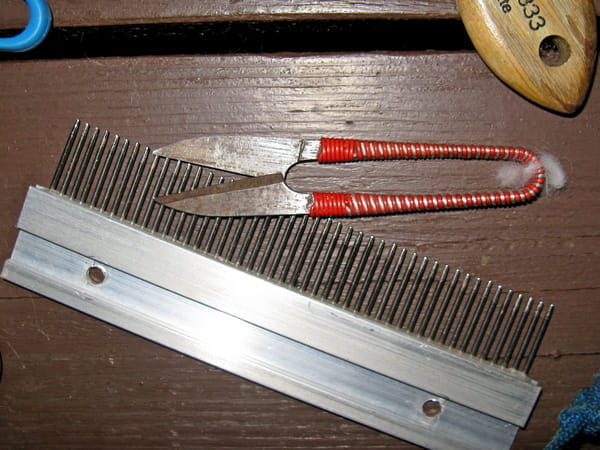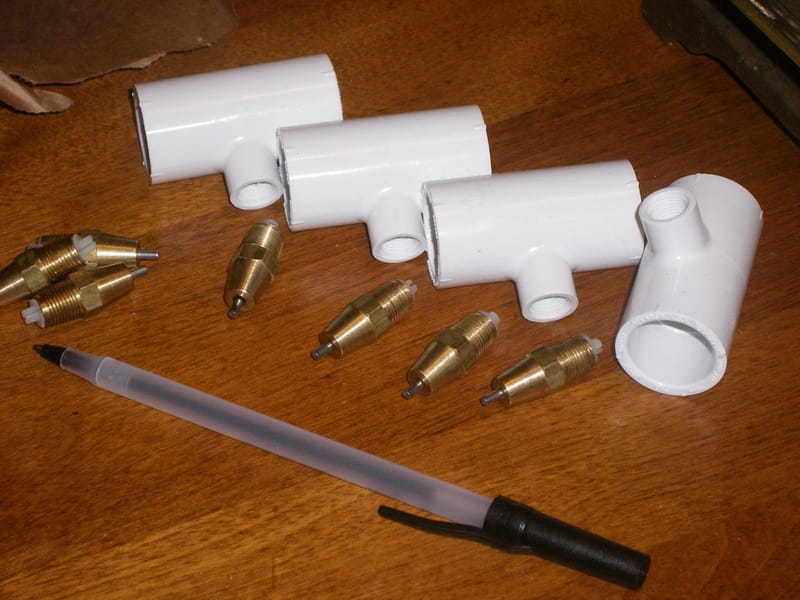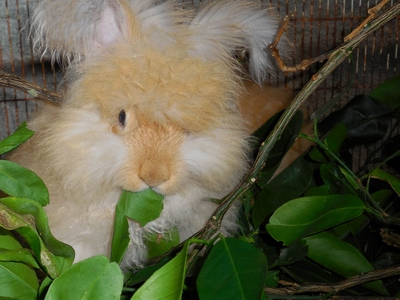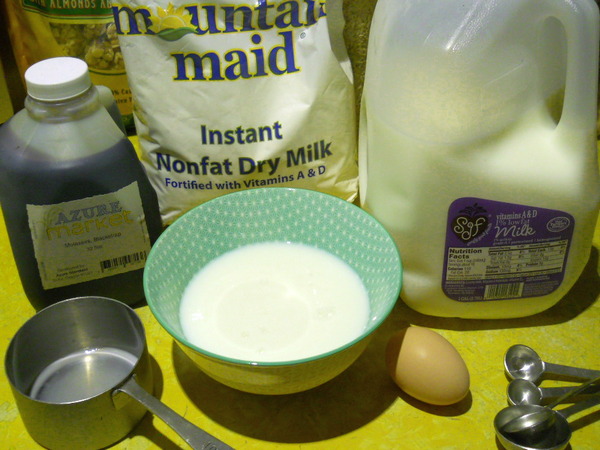Hillside Farm Hawaii
The care and keeping of Bunnies
especially angora bunnies
 .
.
Click on the picture to go to the
Grooming Page
Most angora bunnies, but especially the English angora bunnies (which are the ones we have here), are fuzzy to the point of absurd. There's this total pile of fluff, insanely soft fluff - that moves and eats ti leaves. At least, you suspect they're eating ti leaves, the ti leaf disappears when the ball of fluff is neaby and you heard chewing noises. When they are in full coat, it's hard to tell which end is which unless you put out a tasty treat and see which part is the leading edge of the ball of fluff. HOWEVER, they don't stay fluffy on their own, they need help or they will become a matted mess.
Angora bunnies require the same general care as any bunny else. Access to water, food and space to move around to begin with. Note, that is just the minimum requirements, not the optimum. Angora bunnies also have some fairly severe grooming requirements and that is mostly what keeps them from being a great pet bunny. If you're not going to use the fiber, then in general these incredibly cute and sweet bunnies are just too much maintenance for a mere pet and aren't recommended to be a pet bunny. Angoras from here who have gone to 'pet' homes to folks who swore they were going to take care of their bunny seemed to find it "too much work", "too difficult to find a groomer" who would groom a bunny and "too expensive" if they did. All this was within several months and a bunny lives (or at least should live) a lot longer than that. Well, enough ranting, let's start out by checking the bunny care basics and then move onto angora specific bunny care things.
There's lots of different ways to keep an angora bunny healthy, happy and fluffy, these are just some of the ways we try to manage here at Hillside Farm in Hawaii. Depending on your location and purpose for keeping angora bunnies, your methods will probably be different, but perhaps by having an idea of one method of angora bunny care, it may give you a few good ideas for your own bunnies.
The primary goal we have in the care and keeping of the angora bunnies here at Hillside Farm is for fiber production. We want the best fiber in long lengths suitable for spinning into Hula Bunny yarn. Technically, these bunnies are 'livestock' although they are some of the cutest livestock on the planet. At least, I think so. If you're keeping your angora bunnies as show bunnies and want to take them to bunny shows and win ribbons and points, then probably you'll use different techniques in their coat care. Show bunnies usually get their coats blown out with a blower, we pluck, clip or shear them to near naked about every three to four months. Which isn't usually recommended for a show bunny.
Well, lets go check into how to keep any bunny healthy and happy and then get into angora details afterwards - first things are health and happiness, then fluff. Still, all the bunnies here are angoras, so there will be a lot of mention of fluff and stuff even though a lot of the basic care and keeping works for all bunnies.
Bunny Water
 .
.
Click on the picture to go to the
Hutch Building Page
To begin with, clean clear water is one of the main requirements for happy healthy bunnies, although with bunnies and especially angoras, you only want the water on the inside of the bunny, not the outside. Angora wool mats when it gets wet, so keeping the outside of the bunny dry while hydrating the inside is the best way to keep their wool fluffy. If you have just one bunny, then a water bottle may be your best choice. When angora wool repeatedly gets wet, it mats together. When angora bunnies drink from a water dish or crock, they get the wool under their chin wet and that makes a hard to reach mat under their chin. It generally can't be combed out and has to be snipped off, but to do that, it's generally an upside down and not especially thrilled bunny. So, to save the bother of snipping mats out from under their chin, just choose a water bottle over a water crock or dish and keep everyone happy.
They also seem to prefer the kind of water bottle with the ball at the end of the spout instead of the ones with the little wire lever. Probably easier on their tongue. We've done 'scientific' bunny tests of giving them the choice of two different types of water bottles - one with the ball and one with the little pointy lever - and they consistently empty the water bottle with the ball first. It may not be exactly true scientific evidence, but I'm guessing the ball tipped bottles are much more bunny approved.
Should you have multiple bunnies, then water bottles can become quite the chore. Other than keeping them full, they also need cleaning since moss seems to grow in them, at least, it does around here but we may have more sun than many places. Should you be tired of filling water bottles, a piped in water system may be worth investigating. Clicking on the picture of the water nipples and pipe attachments should take you over to the hutch building page.
I prefer the automatic water system not only for the ease of use, but because it gives me less time on bunny maintenance and more bunny time to play with the bunnies. There is also the comfort in knowing that they will always have water even on hot days when they like to drink a lot. However, the water nipples should be occasionally checked to make sure they're functional. We've had the water system set up in several different configurations (we keep moving the bunny yard to a new location) and so far only one nipple has had issues so they are pretty durable. They screw into a PVC fitting, so if you have a few spare nipples, should anything go wrong with one, it's an easy fix.
So however it works best for you and your bunnies, clear clean water is important for your bunnies' health and well being. If for some reason they aren't eating all their food, check their water supply. A thirsty bunny won't want to eat their pellets so keeping track of their food intake is a good way to keep track of their water supply as well.
Bunny Feeding
 .
.
Click on the picture to go to the
Tropical Forages Page
As with all bunnies, angoras eat fairly low on the food chain. 'Low on the food chain' is stuff such as carrot tops instead of carrot root and leaves and twigs of the fruit trees instead of the fruits. Mulberry leaves are especially nutritious. Grasses and hay are really good for them, although when harvesting grass make sure it hasn't been treated with chemicals. They need more fiber than rich food in their diet and they need lots of fiber to keep their systems moving. This is typical for all rabbits, but since angoras have long hair and groom themselves by licking, they end up ingesting lots of long hair. If they have a lot of food fiber in their diet, then the wool fiber from their coat that they ingest will pass through their system and not cause trouble. If they don't get enough food fiber and ingest too much of their wool fiber, then they can get 'wool block' and will starve to death since they can't eat any food since their tummies are already full of inedible wool that can't pass through. Bunnies can not cough up hairballs like cats can, so if they get too much wool fiber in them, they're in trouble. Since the bunnies here at Hillside Farm Hawaii are for producing fiber, we have a tendency to give them a haircut as soon as their coat gets long enough to be useful so we haven't had much trouble with wool block. We also feed them a lot of fresh forage which keeps them running smoothly. Well, on the inside, anyway. The outside of an angora bunny is more of a lazy hopper than a runner.
Angora bunnies need somewhat low calorie, high fiber AND high protein foods to help them grow their coats. To start with, if you live somewhere that hay is available, constant access to high quality hay helps keep their system clear. However, hay also sticks into their wool, so keeping it in a hay net may help with that. Since the bunnies here live in Hawaii and Hawaii is about 2,500 miles (or more) away from the major hay growing areas, a small square bale of hay in Hawaii costs well over $35 so we don't feed much hay to the bunnies here. We also have really high humidity so keeping a bale of hay mildew free is a major problem. We do have loads of fresh forage 24/7/365 so the bunnies here get lots of forage instead. It's primarily ti leaves, citrus leaves, assorted grasses, herbs and other green growies from the yard. They're quite happy with leaves and twigs, they don't need fancy food or very much fruits and or grain. They actually do better with a fairly plain diet, if you want to give your bunny a treat, try carrot tops, parsley, dandelions, a handful of fresh grass or some other fresh green thing. If they aren't used to fresh green things, then just give them a little bit to start with and work up from there on a daily basis.
However, know the source of the greens. Only get the greens from areas where you know there hasn't been sprays used since weed poison is not good for bunnies at all. Also, make sure that what you give them is healthy for them to eat. Not all green things are healthy for bunnies, some of it is even fatal. Avocado leaves are NOT good for bunnies, the same with tomato leaves and vines as well as potato and eggplant leaves and vines. Tomato, potato, eggplant and peppers are all in the nightshade family, so I'm guessing nightshades are no good for bunnies.
What we did here was go through the yard and source healthy green things for the bunnies and made a list of what can be picked and given to them. In our yard - your yard may be different - we have ti leaves, banana leaves, citrus leaves, apple leaves, dandelions, plantain (the small green type found in lawns, not the banana type), strawberry leaves, parsley, rosemary (good for their coat although not all of them like it), moringa, pigeon pea, hapuu fern, elephant grass, Guinea grass and other assorted insanely tall grasses and I'm sure there's lots of others out there that I've forgotten. But, if you have a list of bunny edibles in your yard, that makes it a lot easier to pick and feed fresh forage to your bunnies. If they're not used to fresh forage, start them out on a little bit at a time. Also, if they've only been fed pellets their entire life, they may not like fresh forages since they're not used to them.
Other than feeding lots of forage, for angoras, we also feed high protein rabbit pellets and add in some additional things. If you're feeding one bunny, a complete high protein bunny pellet is probably the easiest way to feed your bunny and not worry too much about adding in more ingredients. Frequently high protein rabbit feeds will be labelled "Performance" or "Show" or some such name as that. Check the tag and get the highest protein you can. Also, get the kind of pellet that is all green, not the type with strange colored bits added in. Bunnies don't need dried fruit bits in their pellets, just plain hay and grasses made into pellets is a good thing. Try buying feed from a farm or feed store instead of a pet shop, it will be less expensive and probably healthier for your bunny since the pet shops frequently only source the 'fancy' feed with all the strange colored bits added in. The feed store will usually sell more feed, too, so it's fresher. If you can get a few of those large alfalfa cubes that horses like to eat, those make dandy chew toys for rabbits. Usually they sell them in fifty pound bags which would take awhile for one bunny to eat. Since we have twenty to thirty bunnies, we can get feed in fifty pound bags and mix it, although the additives usually come in five pound bags.
The additives we mix in with the high protein bunny pellets are usually rolled barley when we can get it. If the feed store is out of rolled barley, then dry COB (Corn, Oats & Barley) is a good substitute. 'Dry' COB doesn't have any molasses on it. Bunnies have a high enough metabolism, they do NOT need added sugars. The only time we will feed molasses is when bottle feeding baby bunnies. Click on the picture for the page about bottle feeding baby bunnies, that's not a frequent occurance around here, but sometimes is necessary.
 .
.
Click on the picture to go to the
Bottle Feeding Page
As far as how much to feed them, if they were our bunnies, we'd start out with all the hay they can eat and a cup of pellets per bunny per day. This is what we feed our English angoras and they're basically a six pound rabbit. If your bunny is bigger or smaller adjust the amounts. Each week, check the bunny to see how much flesh is on the bunny and to evaluate if they are getting the proper amount of food. If they are too fat, lower the amount. If you can easily feel their spine or they seem thin, then increase the amount. If they need more fattening up, then some Black Oil Sunflower Seeds (commonly referred to as 'BOSS' for obvious reasons) can be added to their diet. The BOSS is also good for improving their coats. We also occasionally will add a little bit of Calf Manna, not exactly sure what it is, but it's great for pregnant does and does feeding babies. We also like to add a bit of oatmeal or other rolled grains when they need a bit more conditioning (fattening up). Watching and feeling your bunnies will tell you a lot about what they need.
The bunnies here are fed as much fresh forage as we can give them. They pretty much have access to their alfalfa pellets at all times and they get a small amount of the grain/BOSS/calf manna every other day or so. Or sometimes we just mix the calf manna, BOSS & rolled grains in with the pellets and feed them the mix. We did try a top dressing of the BOSS/calf manna/rolled grains and the bunnies would paw through their dish to get the bits they liked and the rest would be wasted. When it's all mixed together they don't dig in the food dish as much.
Bunny Space
 .
.
.
Click on the picture to go to the
Bunny Hutches Page
The title of 'Bunny Space' almost sounds like little bunnies on moon rockets or some such thing, doesn't it? Well, it's more about room for them to move more than bunnies in moon rockets.
Frequently, the easy answer to housing a bunny is to buy a 'bunny cage' from some sort of pet supply or farm store and stash the bunny in there. Unfortunately, I think many of those cages are actually designed for hamsters or gerbils or some such much smaller animal. For an English angora the MINIMUM (note: that's "minimum" not "optimum") amount of space for one single bunny should be at least 3' x 2.5'. Or 36" x 30" if you're doing inches. Or for our internationally inclined website folks, that's roughly 91 by 76 centimeters, which should be about .9 x .76 meters. If you can add in a ledge or a box to climb on or in that will increase the bunny's floor space without increasing the amount of space their hutch takes up. There is also the head space, they like having more space above them than most of those prebuilt cages provide. Minimum two feet or two thirds of a meter but higher is better, at least the bunnies here seem to think so. Higher also allows for a variety of levels within their bunny space. This allows them to stand up and look around when they want to. They like having a more interesting space than a blank box.
When making the additional levels within the bunny space, keep in mind that bunny feet are pretty small so don't use anything with wide spaces for creating additional floor area. We used refrigerator racks for interior raised levels with our first bunny hutch and one of our bunnies got it's foot caught in the wires. Unhappy bunny! So, be mindful of possible bunny dangers in hutch construction. Ends of wires should point away from the bunny space so they won't scratch the bunnies, openings in wires should be close enough that bunny parts don't fall through and get stuck. Wood should be untreated (Hawaii lumber is frequently treated for termites) so if/when the bunnies chew on it, they won't be poisoned.
For the hutches here at Hillside Farm, about the only 'standard' hutch construction item we use is 1" x 1/2" wire floors. It is a galvanized 30" wide wire that comes in ten foot rolls. It's got holes of 1" x 1/2" and it is installed with the 1/2" wires facing up. This is about the only constant thing that has been used for all the hutches. This wire floor allows bunny 'berries' to drop through and yet has enough support that they don't get sore feet from the wire. English angoras have lots of wool on their feet, so they're good on wire. The wire floor keeps their wool from dragging through messes and since we are raising them for their fiber production, keeping the fiber clean is important. I'm sure the bunnies are happier without messy undercarriages, too. If you have bunnies with less wool on their feet, giving them a bit of wooden board or a big ceramic tile to sit on can give them a place to rest their feet.
So get creative with your bunny spaces. We use the wire floors to keep their wool clean, give them enough space that they can move around and find interesting areas in their hutch. Provide them with clean water and healthy food and you'll have healthy happy bunnies. It's much easier to keep a bunny healthy than it is to try to cure a sick one. Plus healthy bunnies are happy bunnies.

Meet Your Fiber Providers
If you like, you can send us an email and ask about bunnies, yarn, Hawaii things, what we should have on our webpage or just about anything else.
 .
. .
. .
. .
.
